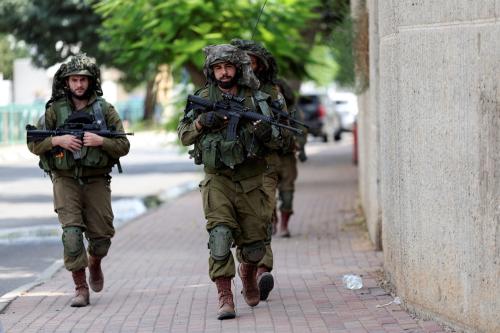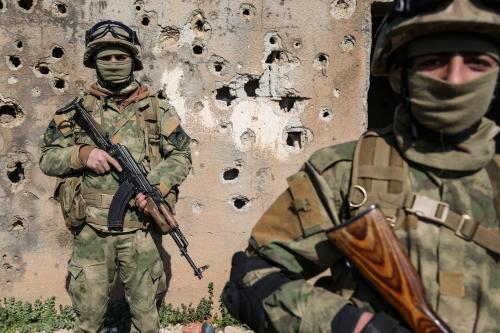The current U.S. administration has wrapped up U.S. involvement in a mistaken war in Iraq (albeit on a schedule set by the previous administration, and with subsequent reintroduction of some U.S. military personnel into Iraq), has wound down U.S. involvement in a war in Afghanistan that had metamorphosed from a counterterrorist operation into a nation-building attempt (albeit only after an Obama-era “surge” and now with apparent second thoughts about how much longer the 13-year-old U.S. military involvement will continue), and has resisted pressure to throw U.S. troops into the civil war in Syria (albeit while employing other forms of U.S. military involvement, including airstrikes). The general direction of the administration’s policies (though not some of the exceptions and detours) has been sound in terms of both the proper criteria for expending American blood and treasure and the effectiveness, or limitations thereof, of applying U.S. military force in internal conflicts such as the ones in those lands. Some observers would say that this overall direction also has been good politics given the lack of enthusiasm of the American public, still feeling some effects of an Iraq War syndrome, for getting involved any time soon in anything that could be described as—in the legally fuzzy but politically relevant term in the administration’s draft authorization for use of military force against ISIS—“enduring offensive ground combat operations.”
That last element may be changing. A just-released poll of American opinion by the Pew Research Center shows a significant shift in the last few months in favor of more extensive use of military force against ISIS. A question asked in October 2014 about possible use of ground forces against the group showed 39 percent in favor and 55 percent opposed. The same question in February 2015 showed an almost even split: 47 percent in favor and 49 percent opposed. There have been comparable shifts over the past year in responses to questions about support for the overall campaign against ISIS and about the best approach to “defeating global terrorism.” On that last question, those saying “using overwhelming military force is the best way to defeat terrorism” rose from 37 percent in March 2014 to 47 percent in February 2015. Those saying that “relying too much on military force to defeat terrorism creates hatred and more terrorism” decreased from 57 percent to 46 percent.
Several patterns in American public attitudes toward—and hence also in the political handling of—use of military force are at work in the views recorded by such polls, and have been displayed repeatedly in the past. One is that sentiments, either for or against use of military force, fade over time as whatever gave rise to the sentiment recedes farther into the past. There is regression toward the mean. This is true of militancy-stoking events, but it also is true of war-avoiding syndromes following failed wars.
Also at work is a heavy dose of emotion, usually embracing anger as well as fear, associated with the militancy-stoking events but also resting on beliefs that such events signify some broader threat. Probably the most glaring example is the American public response to the 9/11 terrorist attack, which involved an abrupt upward surge in militancy and in the willingness of the American public to use military force. The emotion concentrated on that one event was associated in the public mind with a broader perceived terrorist threat against the United States. The slide of the United States into the Vietnam War featured specific emotion-arousing incidents such as attacks (or supposed attacks) against U.S. warships in the Gulf of Tonkin, seen as manifestations of a larger Communist threat against U.S. interests.
Today ISIS arouses emotions especially with its grisly killings of captives, including Americans and other Westerners. There is again a popular perception of a connection with broader and more direct threats against the West and the United States. The significant shift over the past four months in sentiment about use of force against ISIS is probably connected to high-profile attacks in Western cities that—even though there may be little or no organizational connection to the ISIS that is waging war in Iraq and Syria—have been seen in the American public mind as all part of the same threat, and a threat to which the United States is vulnerable. Polling five months ago was already showing a large majority of Americans believing that ISIS had resources in place to conduct attacks within the United States.
Another mechanism in play is a classic form of the slippery slope, in which even a small degree of commitment to some objective overseas leads incrementally to larger commitments of resources on behalf of the same objective. The main decisions of the Johnson administration in the mid-1960s to escalate in a big way in Vietnam were based directly on the positing of the objective during the Kennedy administration of keeping South Vietnam non-Communist. The makers of the Iraq War in the George W. Bush administration were able to point to legislation signed by President Clinton that declared regime change in Iraq to be a U.S. policy objective, and to ask whether the United States was going to act to realize that objective. Besides the sheer slipperiness of such slopes, there also is commonly invoked the argument, however invalid, that U.S. credibility would suffer if the United States were to back away from any such objectives or perceived objectives.
Finally, not least important, partisanship and fears of domestic political losses often are a major factor. When Lyndon Johnson was deciding how to respond to the Gulf of Tonkin incident in 1964 he was running for his own presidential term against Barry Goldwater, who was beating the drums about Vietnam, criticizing the president (in Goldwater’s acceptance speech at the Republican convention) for not clearly indicating “whether or not the objective over there is victory,” and saying, “I needn’t remind you, but I will, it has been during Democratic years that a billion persons were cast into Communist captivity and their fates cynically sealed.”
And now, Republican presidential contenders see a push for more extensive U.S. military involvement against ISIS as an opportune, or maybe even a necessary, campaign strategy. As Jonathan Martin and Jeremy Peters write in the New York Times, this tack “is a tacit acknowledgment by Republicans that, with the economy improving, they need another issue to distinguish themselves from Democrats. And it offers them a way to link former Secretary of State Hillary Rodham Clinton to President Obama on an issue where the president’s approval ratings are weakening.”
Note that none of these factors shaping popular sentiment, and its reflection in what the political class says, are ingredients in sound foreign policy. They are instead a matter of popular inattention, public emotion, the hazards of incremental decision-making, and partisan politicking. Such things have led the United States in the past into bad, costly policies overseas, and they could do so again.
Note also that the American public doesn’t seek long, costly wars. Americans just think, mistakenly as it has sometimes turned out, that uses of military force they do favor will be short and not all that costly. The pollster John Zogby notes that although public support for use of military force against terrorists was quite high in the wake of 9/11, the degree of support went down precipitously if the question projected a duration of the use of military force extending beyond a couple of years.
A lesson is to be very careful in the early stages of an overseas commitment, keeping in mind that it could be the first part of a slippery slope even if it is not immediately recognizable as such, and to eschew objectives the pursuit of which could become much costlier in the future than they are so far. Some past disasters might have been averted near the beginning of the slide if this sort of thinking had prevailed. This would have meant avoiding, two or three years before Johnson escalated the country into what we know as the Vietnam War, any declaration that Communist unification of Vietnam was a major U.S. objective. It also would have meant not enshrining as the law of the land in the 1990s an objective of regime change in Iraq.
The poll results about growing public support for use of ground troops against ISIS are an indication that we may again be on the first part of a slide into a larger war. We might not go far down the slide during the remainder of Barack Obama’s term, but that guarantees nothing about what will subsequently happen regarding U.S. involvement in Iraq and Syria. Although it is possible that ISIS will flame out by then, that isn’t guaranteed either. The civil war in Syria in particular seems likely to be long-lasting. And even if ISIS isn’t generating as much fear a couple of years ago as it is now, we no doubt will hear reminders about how removal of the Assad regime was supposedly a U.S. objective too.
This piece was originally published by The National Interest.



Commentary
Op-edAre Americans sliding into another war?
February 25, 2015